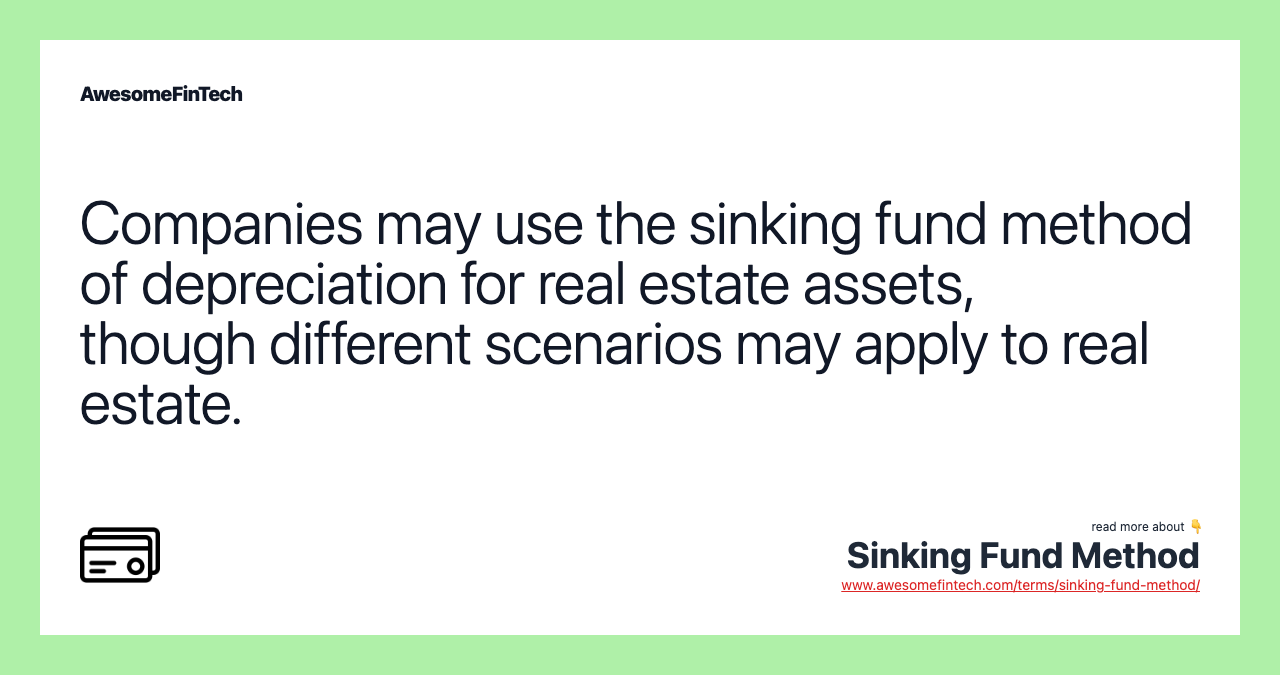Sinking Fund Method
The sinking fund method is a technique for depreciating an asset while generating enough money to replace it at the end of its useful life. Under this method, the amount of money added to the asset-replacement fund each year is calculated by determining the cost to replace the asset, how many years the asset is expected to last, and the expected rate of return on the investment, as well as potential earnings from the effects of compounding interest. Companies may use the sinking fund method of depreciation for real estate assets, though different scenarios may apply to real estate. For companies that want to put money aside to purchase a replacement asset upon the full depreciation of the old one, the sinking fund method may be a viable option. The sinking fund method is a depreciation technique used to finance the replacement of an asset at the end of its useful life.

What Is the Sinking Fund Method?
The sinking fund method is a technique for depreciating an asset while generating enough money to replace it at the end of its useful life.
As depreciation charges are incurred to reflect the asset's falling value, a matching amount of cash is invested. These funds sit in a sinking fund account and generate interest.




Understanding the Sinking Fund Method
Companies use depreciation to expense an asset over time, not just in the period that it was purchased. In other words, depreciation involves stretching out the cost of assets over many different accounting periods, enabling companies to benefit from them without deducting the full cost from net income (NI).
One of the biggest challenges of depreciation is determining how much to expense. For companies that want to put money aside to purchase a replacement asset upon the full depreciation of the old one, the sinking fund method may be a viable option.
Under this method, the amount of money added to the asset-replacement fund each year is calculated by determining the cost to replace the asset, how many years the asset is expected to last, and the expected rate of return on the investment, as well as potential earnings from the effects of compounding interest.
In most cases, sinking funds invest in government-backed securities, such as Treasury notes, bills, and bonds. Investments matching the duration of the asset's life are usually used, but shorter-term investments can be reinvested. The asset's depreciation schedule determines the investment amounts.
The sinking fund method is mainly used by large-scale industries, such as utility companies, that require expensive, long-term assets to function.
Additionally, companies may also use the sinking fund method of depreciation for real estate assets. Different scenarios may apply to real estate assets, but one of the most common is depreciation for lease renewals. In this situation, a depreciation schedule is based on the lease term and expected interest.
Special Considerations
Most companies rarely use the sinking fund method, preferring instead to employ the simpler straight-line or declining balance depreciation techniques.
The sinking fund method is seen as complex, particularly as it requires the use of a separate replacement fund for each asset. Moreover, companies recognize that the cost of replacing an old asset can change over time and are also mindful that it is difficult to put enough cash aside when interest rates are unpredictable and consistently fluctuate.
Important
When interest rates cannot reasonably be predicted, the sinking fund method is generally undesirable.
In addition to the added complexities of the sinking fund method, there are other reasons why this method is not suitable. For example, some companies prefer to invest capital resources in other areas with more promising returns.
While the sinking fund provides for the purchase of a new asset at the end of the former's useful life, some firms prefer to instead use their working capital for this purchase. Also, companies wanting to keep their depreciation expenses low find this method unfavorable.
Related terms:
Accounting Period
An accounting period is an established range of time during which accounting functions are performed and analyzed including a calendar or fiscal year. read more
Alternative Depreciation System (ADS)
Alternative Depreciation System is a depreciation schedule with a straight-line recovery period that generally better reflects the asset's income. read more
Amortization of Intangibles
Amortization of intangibles is the process of expensing the cost of an intangible asset over the projected life of the asset. read more
Asset
An asset is a resource with economic value that an individual or corporation owns or controls with the expectation that it will provide a future benefit. read more
Compound Interest , Formula, & Calculation
Compound interest is the interest on a loan or deposit that accrues on both the initial principal and the accumulated interest from previous periods. read more
Declining Balance Method
In using the declining balance method, a company reports larger depreciation expenses during the earlier years of an asset’s useful life. read more
Depreciation
Depreciation is an accounting method of allocating the cost of a tangible asset over its useful life and is used to account for declines in value over time. read more
Government Bond
A government bond is issued by a government at the federal, state, or local level to raise debt capital. Treasuries are issued at the federal level. read more
Interest Rate , Formula, & Calculation
The interest rate is the amount lenders charge borrowers and is a percentage of the principal. It is also the amount earned from deposit accounts. read more
Net Income (NI)
Net income, also called net earnings, is sales minus cost of goods sold, general expenses, taxes, and interest. read more